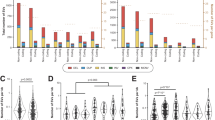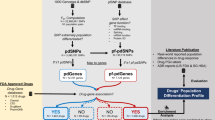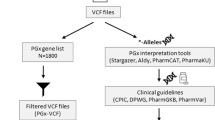Abstract
In order to identify single-nucleotide polymorphisms (SNPs) and analyze their characteristics in a set of 111 genes, we resequenced exons and flanking regions in an average of 170 chromosomes from individuals of European origin. Genetic variability was decreased in noncoding regions highly conserved between human and rodents, indicating functional relevance of these regions. Furthermore, diversity of coding nonsynonymous SNPs was found lower in regions encoding a known protein sequence motif. SNPs predicted to be of functional significance were more common amongst rare variants. Despite the significant recent growth of SNP numbers in public SNP databases, only a small fraction of these rare variants is represented. This may be relevant in the investigation of the genetic causes of severe side effects, for which rare variants are plausible candidates. Estimation of htSNPs reduces the genotyping effort required in capturing common haplotypes, for certain genes, however, this accounts for only a small fraction of haplotype diversity.
This is a preview of subscription content, access via your institution
Access options
Subscribe to this journal
Receive 6 print issues and online access
$259.00 per year
only $43.17 per issue
Buy this article
- Purchase on Springer Link
- Instant access to full article PDF
Prices may be subject to local taxes which are calculated during checkout

Similar content being viewed by others
References
Goldstein DB, Tate SK, Sisodiya SM . Pharmacogenetics goes genomic. Nat Rev Genet 2003; 4: 937–947.
Evans WE, Johnson JA . Pharmacogenomics: the inherited basis for interindividual differences in drug response. Annu Rev Genomics Hum Genet 2001; 2: 9–39.
Consortium TIH . The International HapMap Project. Nature 2003; 426: 789–796.
Leabman MK, Huang CC, DeYoung J, Carlson EJ, Taylor TR, de la Cruz M et al. Natural variation in human membrane transporter genes reveals evolutionary and functional constraints. Proc Natl Acad Sci USA 2003; 100: 5896–5901.
Freudenberg-Hua Y, Freudenberg J, Kluck N, Cichon S, Propping P, Nothen MM . Single nucleotide variation analysis in 65 candidate genes for CNS disorders in a representative sample of the European population. Genome Res 2003; 13: 2271–2276.
Sunyaev SR, Lathe III WC, Ramensky VE, Bork P . SNP frequencies in human genes an excess of rare alleles and differing modes of selection. Trends Genet 2000; 16: 335–337.
Abbott A . With your genes? Take one of these, three times a day. Nature 2003; 425: 760–762.
Halushka MK, Fan JB, Bentley K, Hsie L, Shen N, Weder A et al. Patterns of single-nucleotide polymorphisms in candidate genes for blood-pressure homeostasis. Nat Genet 1999; 22: 239–247.
Cargill M, Altshuler D, Ireland J, Sklar P, Ardlie K, Patil N et al. Characterization of single-nucleotide polymorphisms in coding regions of human genes. Nat Genet 1999; 22: 231–238.
Tiret L, Poirier O, Nicaud V, Barbaux S, Herrmann SM, Perret C et al. Heterogeneity of linkage disequilibrium in human genes has implications for association studies of common diseases. Hum Mol Genet 2002; 11: 419–429.
Bateman A, Coin L, Durbin R, Finn RD, Hollich V, Griffiths-Jones S et al. The Pfam protein families database. Nucleic Acids Res 2004; 32 Database issue: D138–D141.
Hulo N, Sigrist CJ, Le Saux V, Langendijk-Genevaux PS, Bordoli L, Gattiker A et al. Recent improvements to the PROSITE database. Nucleic Acids Res 2004; 32 Database issue: D134–D137.
Schwartz S, Kent WJ, Smit A, Zhang Z, Baertsch R, Hardison RC et al. Human-mouse alignments with BLASTZ. Genome Res 2003; 13: 103–107.
Birney E, Andrews D, Bevan P, Caccamo M, Cameron G, Chen Y et al. Ensembl 2004. Nucleic Acids Res 2004; 32: D468–D470.
Johnson GC, Esposito L, Barratt BJ, Smith AN, Heward J, Di Genova G et al. Haplotype tagging for the identification of common disease genes. Nat Genet 2001; 29: 233–237.
Palmer LJ, Silverman ES, Weiss ST, Drazen JM . Pharmacogenetics of asthma. Am J Respir Crit Care Med 2002; 165: 861–866.
Hwa J, Garriga P, Liu X, Khorana HG . Structure and function in rhodopsin: packing of the helices in the transmembrane domain and folding to a tertiary structure in the intradiscal domain are coupled. Proc Natl Acad Sci USA 1997; 94: 10571–10576.
Bosch L, Ramon E, Del Valle LJ, Garriga P . Structural and functional role of helices I and II in rhodopsin. A novel interplay evidenced by mutations at Gly-51 and Gly-89 in the transmembrane domain. J Biol Chem 2003; 278: 20203–20209.
Eiden LE, Schafer MK, Weihe E, Schutz B . The vesicular amine transporter family (SLC18): amine/proton antiporters required for vesicular accumulation and regulated exocytotic secretion of monoamines and acetylcholine. Pflugers Arch 2004; 447: 636–640.
Tsunoda T, Lathrop GM, Sekine A, Yamada R, Takahashi A, Ohnishi Y et al. Variation of gene-based SNPs and linkage disequilibrium patterns in the human genome. Hum Mol Genet 2004; 13: 1623–1632.
Crawford DC, Carlson CS, Rieder MJ, Carrington DP, Yi Q, Smith JD et al. Haplotype diversity across 100 candidate genes for inflammation, lipid metabolism, and blood pressure regulation in two populations. Am J Hum Genet 2004; 74: 610–622.
Wall JD, Pritchard JK . Haplotype blocks and linkage disequilibrium in the human genome. Nat Rev Genet 2003; 4: 587–597.
Wheeler DL, Church DM, Edgar R, Federhen S, Helmberg W, Madden TL et al. Database resources of the National Center for Biotechnology Information: update. Nucleic Acids Res 2004; 32 Database issue: D35–D40.
Altschul SF, Madden TL, Schaffer AA, Zhang J, Zhang Z, Miller W et al. Gapped BLAST and PSI-BLAST: a new generation of protein database search programs. Nucleic Acids Res 1997; 25: 3389–3402.
Rozen S, Skaletsky H . Primer3 on the WWW for general users and for biologist programmers. Methods Mol Biol 2000; 132: 365–386.
Sanger F, Nicklen S, Coulson AR . DNA sequencing with chain-terminating inhibitors. Proc Natl Acad Sci USA 1977; 74: 5463–5467.
Ewing B, Hillier L, Wendl MC, Green P . Base-calling of automated sequencer traces using phred. I. Accuracy assessment. Genome Res 1998; 8: 175–185.
Nickerson DA, Tobe VO, Taylor SL . PolyPhred: automating the detection and genotyping of single nucleotide substitutions using fluorescence-based resequencing. Nucleic Acids Res 1997; 25: 2745–2751.
Gordon D, Abajian C, Green P . Consed: a graphical tool for sequence finishing. Genome Res 1998; 8: 195–202.
Zhang Z, Schwartz S, Wagner L, Miller W . A greedy algorithm for aligning DNA sequences. J Comput Biol 2000; 7: 203–214.
Grantham R . Amino acid difference formula to help explain protein evolution. Science 1974; 185: 862–864.
Hartl DL, Clark AG . Principles of Population Genetics. Sinauer Associates, Inc.: Sunderland, MA, 1997.
Tajima F . Statistical method for testing the neutral mutation hypothesis by DNA polymorphism. Genetics 1989; 123: 585–595.
Risch N, Merikangas K . The future of genetic studies of complex human diseases. Science 1996; 273: 1516–1517.
Avi-Itzhak HI, Su X, De La Vega FM . Selection of minimum subsets of single nucleotide polymorphisms to capture haplotype block diversity. Pac Symp Biocomput 2003: 466–477.
Acknowledgements
We thank Dr Christine Braeman for help in preparing the manuscript. This work was supported by grants from the German Human Genome Project (DHGP) and the German National Genome Research Network (NGFN).
Author information
Authors and Affiliations
Corresponding author
Additional information
Database submission: All SNPs were submitted to dbSNP with complete genotype and flanking sequence information (ss12586678–ss12587076, ss28447039-ss28447415).
DUALITY OF INTEREST
None declared.
Supplementary Information
Supplementary Information accompanies the paper on the The Pharmacogenomics Journal website (http://www.nature.com/tpj).
Rights and permissions
About this article
Cite this article
Freudenberg-Hua, Y., Freudenberg, J., Winantea, J. et al. Systematic investigation of genetic variability in 111 human genes—implications for studying variable drug response. Pharmacogenomics J 5, 183–192 (2005). https://doi.org/10.1038/sj.tpj.6500306
Received:
Revised:
Accepted:
Published:
Issue Date:
DOI: https://doi.org/10.1038/sj.tpj.6500306
Keywords
This article is cited by
-
Bioinformatic analysis of human CNS-expressed ion channels as candidates for episodic nervous system disorders
Neurogenetics (2007)
-
A summary statistic approach to sequence variation in noncoding regions of six schizophrenia-associated gene loci
European Journal of Human Genetics (2006)
-
Pharmacogenetics and the concept of individualized medicine
The Pharmacogenomics Journal (2006)



